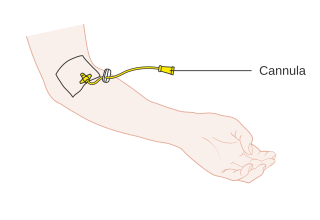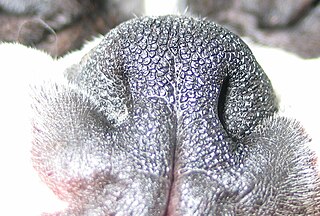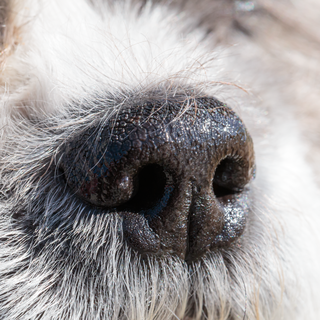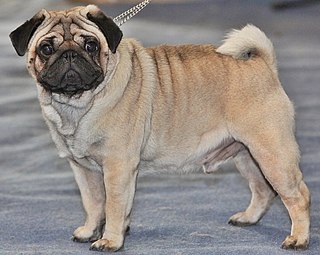Related Research Articles

Veterinary medicine is the branch of medicine that deals with the prevention, control, diagnosis, and treatment of disease, disorder, and injury in animals. Along with this, it also deals with animal rearing, husbandry, breeding, research on nutrition and product development. The scope of veterinary medicine is wide, covering all animal species, both domesticated and wild, with a wide range of conditions which can affect different species.
Plastic surgery is a surgical specialty involving the restoration, reconstruction, or alteration of the human body. It can be divided into two main categories: reconstructive surgery and cosmetic surgery. Reconstructive surgery includes craniofacial surgery, hand surgery, microsurgery, and the treatment of burns. While reconstructive surgery aims to reconstruct a part of the body or improve its functioning, cosmetic surgery aims at improving the appearance of it. Both of these techniques are used throughout the world.

A nostril is one of the two channels of the nose, from the point where they bifurcate to the external opening. In birds and mammals, they contain branched bones or cartilages called turbinates, whose function is to warm air on inhalation and remove moisture on exhalation. Fish do not breathe through their noses, but they do have two small holes used for smelling, which can be referred to as nostrils.

Nose piercing is the piercing of the skin or cartilage which forms any part of the nose, normally for the purpose of wearing jewelry, called a nose-jewel. Among the different varieties of nose piercings, the nostril piercing is the most common. Nose piercing is the third most common variety of piercing after earlobe piercing and tongue piercing.

Rhinoplasty, commonly known as a nose job, is a plastic surgery procedure for altering and reconstructing the nose. There are two types of plastic surgery used – reconstructive surgery that restores the form and functions of the nose and cosmetic surgery that changes the appearance of the nose. Reconstructive surgery seeks to resolve nasal injuries caused by various traumas including blunt, and penetrating trauma and trauma caused by blast injury. Reconstructive surgery also treats birth defects, breathing problems, and failed primary rhinoplasties. Rhinoplasty may remove a bump, narrow nostril width, change the angle between the nose and the mouth, or address injuries, birth defects, or other problems that affect breathing, such as a deviated nasal septum or a sinus condition.

A cannula is a tube that can be inserted into the body, often for the delivery or removal of fluid or for the gathering of samples. In simple terms, a cannula can surround the inner or outer surfaces of a trocar needle thus extending the effective needle length by at least half the length of the original needle. It is also called an intravenous (IV) cannula. Its size mainly ranges from 14 to 24 gauge. Different-sized cannula have different colours as coded.

Nasogastric intubation is a medical process involving the insertion of a plastic tube through the nose, past the throat, and down into the stomach. Orogastric intubation is a similar process involving the insertion of a plastic tube through the mouth. Abraham Louis Levin invented the NG tube.

Vaginoplasty is any surgical procedure that results in the construction or reconstruction of the vagina. It is a type of genitoplasty. Pelvic organ prolapse is often treated with one or more surgeries to repair the vagina. Sometimes a vaginoplasty is needed following the treatment or removal of malignant growths or abscesses in order to restore a normal vaginal structure and function. Surgery to the vagina is done to correct congenital defects to the vagina, urethra and rectum. It will correct protrusion of the urinary bladder into the vagina (cystocele) and protrusion of the rectum (rectocele) into the vagina. Often, a vaginoplasty is performed to repair the vagina and its attached structures due to trauma or injury.

Labiaplasty is a plastic surgery procedure for altering the labia minora and the labia majora, the folds of skin surrounding the human vulva. There are two main categories of women seeking cosmetic genital surgery: those with congenital conditions such as intersex, and those with no underlying condition who experience physical discomfort or wish to alter the appearance of their genitals because they believe they do not fall within a normal range.

Stenotic nares is part of the brachycephalic syndrome of short-nosed dogs. Breeds such as Boxers, Bulldogs, King Charles Spaniels, Pugs, Boston Terriers, Shih Tzus, Lhasa Apsos, etc. are all considered brachycephalic breeds. Stenotic nares means the nostrils are pinched or narrow. This makes it more difficult to breathe and causes snorting and snoring in these animals. It is a congenital trait; these animals are born with it. Veterinarians perform a simple surgery to help widen the nares, often at the same time as a spay or neuter.

The human nose is the most protruding part of the face. It bears the nostrils and is the first organ of the respiratory system. It is also the principal organ in the olfactory system. The shape of the nose is determined by the nasal bones and the nasal cartilages, including the nasal septum which separates the nostrils and divides the nasal cavity into two. On average the nose of a male is larger than that of a female.

A nose is a protuberance in vertebrates that houses the nostrils, or nares, which receive and expel air for respiration alongside the mouth. Behind the nose are the olfactory mucosa and the sinuses. Behind the nasal cavity, air next passes through the pharynx, shared with the digestive system, and then into the rest of the respiratory system. In humans, the nose is located centrally on the face and serves as an alternative respiratory passage especially during suckling for infants.
Pediatric plastic surgery is plastic surgery performed on children. Its procedures are most often conducted for reconstructive or cosmetic purposes. In children, this line is often blurred, as many congenital deformities impair physical function as well as aesthetics.

The pug is a breed of dog distinguished by a wrinkly, short-muzzled face and curled tail. The breed has a fine, glossy coat that comes in a variety of colours, most often light brown (fawn) or black, and a compact, square body with well-developed muscles.

A lip lift is a plastic surgery procedure that modifies the cosmetic appearance of the lips by reshaping them to increase the prominence of the vermilion border; and to enhance the facial area above the lips into a more aesthetically pleasing shape. In corrective praxis, a lip lift procedure is distinguished from lip enhancement, the augmentation of the lips, which can be effected with a non-surgical procedure.
Jocelyn Wildenstein is an American socialite known for her extensive cosmetic surgery, resulting in her catlike appearance; her 1999 high-profile divorce from billionaire art dealer and businessman Alec Wildenstein; and her extravagant lifestyle and subsequent bankruptcy filing.

Brachycephalic syndrome is a pathological condition affecting short nosed dogs and cats which can lead to severe respiratory distress. There are four different anatomical abnormalities that contribute to the disease, all of which occur more commonly in brachycephalic breeds:- an elongated soft palate, stenotic nares, a hypoplastic trachea, and everted laryngeal saccules. Because all of these components make it more difficult to breathe, in situations of exercise, stress, or heat, an animal with these abnormalities may be unable to take deep or fast enough breaths to blow off carbon dioxide. This leads to distress and further increases respiratory rate and heart rate, creating a vicious cycle that can quickly lead to a life-threatening situation.
Non-surgical rhinoplasty is a medical aesthetic procedure in which injectable fillers, most commonly hyaluronic acid ones like Restylane and Juvederm or calcium hydroxyapatite (Radiesse), are used to alter and shape a person's nose without a surgery. The procedure fills in depressed areas on the nose, lifting the angle of the tip or smoothing the appearance of bumps on the bridge. Non surgical rhinoplasty is an augmentation procedure, so it cannot reduce the size of someone's nose. The cosmetic procedure carries the risk of causing serious skin damage or distant complications like blindness. If the filler product is injected into an artery, filler can travel in the arteries and blocks smaller size arteries like ophthalmic artery and cause blindness. If blood vessels of the skin is blocked, skin necrosis can develop. Hyaluronic acid based fillers can be reversed even if injected into a blood vessel with an enzyme called hyaluronidase, which can be also injected like fillers.
Genitoplasty is plastic surgery to the genitals. Genitoplasties may be reconstructive to repair injuries, and damage arising from cancer treatment, or congenital disorders, endocrine conditions, or they may be cosmetic.

Oroantral fistula (OAF) is an epithelialised oroantral communication (OAC). OAC refers to an abnormal connection between the oral cavity and antrum. The creation of an OAC is most commonly due to the extraction of a maxillary (upper) tooth closely related to the antral floor. A small OAC may heal spontaneously but a larger OAC would require surgical closure to prevent the development of persistent OAF and chronic sinusitis.
References
- ↑ Monnet, Eric (2012). "Alaplasty". Small Animal Soft Tissue Surgery. Somerset: Wiley Blackwell. p. 376. ISBN 978-1-118-39291-1. OCLC 947128207.
- ↑ Bojrab, M. Joseph; Waldron, Don Ray; Toombs, James P. (2014). "Stenotic Nares Wedge Resection (Alaplasty)". Current Techniques in Small Animal Surgery (5th ed.). Jackson: Teton NewMedia. p. 386. ISBN 978-1-4987-1656-7. OCLC 894170010.
- 1 2 3 Rinzler, Carol Ann (2010). "alarplasty". The Encyclopedia of Cosmetic and Plastic Surgery. New York: Infobase Publishing. ISBN 978-1-4381-2702-6. OCLC 435912040.
- ↑ Aronson, Lillian R. (2015). "Stenotic nares". Small Animal Surgical Emergencies. Ames: Wiley Blackwell. p. 275. ISBN 978-1-118-48720-4. OCLC 911135242.
| This surgery article is a stub. You can help Wikipedia by expanding it. |